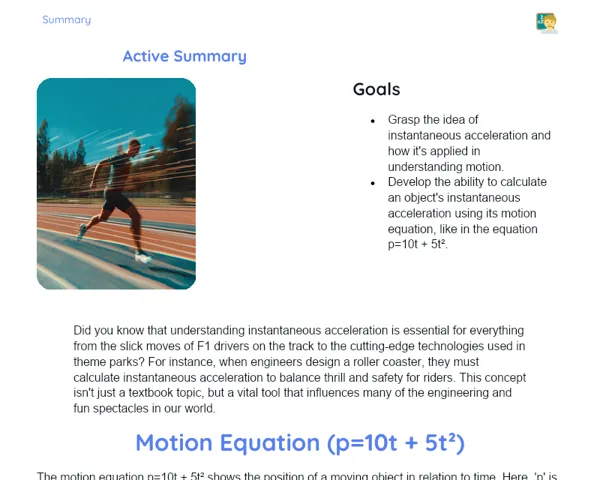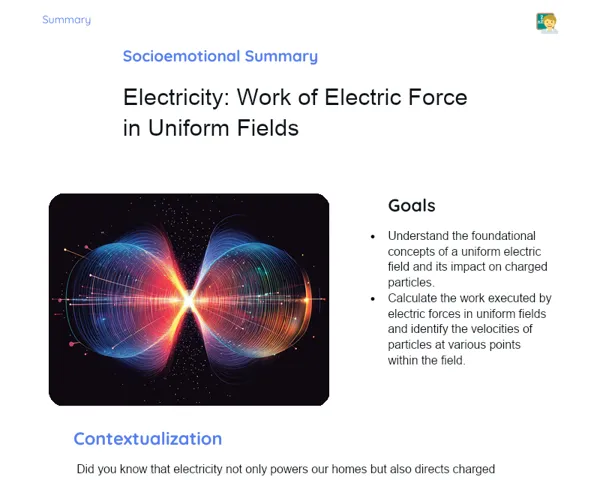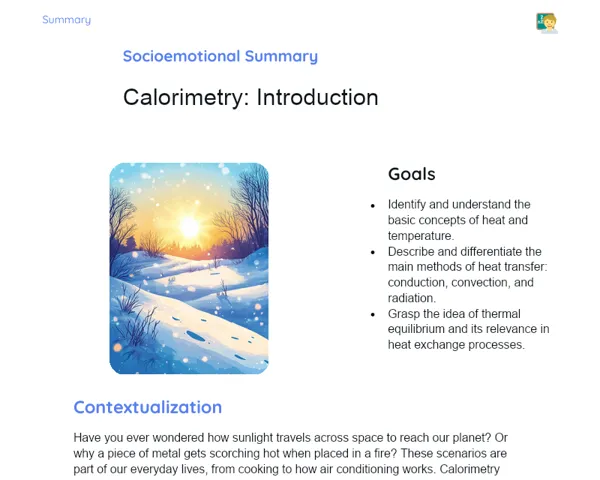Objectives
1. 🎯 Understand and calculate gravitational potential energy, considering mass, gravity, and height as key factors.
2. 🎯 Relate gravitational potential energy to kinetic energy and apply these ideas to determine an object's speed when it rolls down a ramp.
Contextualization
Have you ever considered how gravitational potential energy affects everything from simple toys to complex systems like lifts? 🎢🏗️ This concept is vital for understanding how energy shifts into different types of motion, enabling us to create systems that are essential for our everyday lives. For instance, engineers rely on this knowledge to ensure the safety and efficiency of lifts and amusement parks. By diving into this topic, you gain not just an insight into the physics underpinning these technologies but also learn how to apply this knowledge in practical situations, equipping you for real-world challenges and future scientific breakthroughs!
Important Topics
Gravitational Potential Energy
Gravitational potential energy refers to the energy linked to an object's position within a gravitational field. This energy is calculated by multiplying the object's mass, the acceleration due to gravity, and its height above a reference point. When you elevate an object, its ability to perform work increases as energy gets stored due to the gravitational pull.
-
Formula: Gravitational potential energy (Epg) is given by Epg = mgh, where 'm' is the object's mass, 'g' is the acceleration due to gravity, and 'h' is the height above a reference point.
-
Gravitational potential energy can be transformed into kinetic energy as the object descends, increasing its velocity.
-
Essential for practical applications, such as designing amusement parks and lifts, where effectively converting potential energy into kinetic energy is crucial for safety and performance.
Kinetic Energy
Kinetic energy is the energy that an object possesses due to its motion. It is directly proportional to the square of the object's speed and its mass. When a freely falling object changes its gravitational potential energy into kinetic energy, its speed increases as it loses height.
-
Formula: Kinetic energy (Ec) is calculated as Ec = 0.5mv², where 'm' is the object's mass and 'v' is its speed.
-
Kinetic energy remains conserved in systems where external forces are negligible, allowing for accurate calculations in collisions and projectile motions.
-
Key for understanding how energy is transferred and changed between different forms during physical processes, like when an object moves down an inclined surface.
Relationship between Potential and Kinetic Energy
The connection between potential and kinetic energy is key to grasping how energy is conserved and transformed in physical systems. In an ideal scenario with no losses, the total energy (the sum of potential and kinetic energy) remains constant. This principle, known as the conservation of mechanical energy, is extremely helpful for analysing complex movements.
-
Without non-conservative forces, like friction or air resistance, the total mechanical energy of a system stays constant (law of conservation of energy).
-
During free fall, gravitational potential energy converts into kinetic energy, illustrating energy transfer between forms.
-
Important for tackling physics problems involving changes in height and speed, enabling predictions about mechanical system behaviour.
Key Terms
-
Gravitational Potential Energy: Energy stored due to an object's position in a gravitational field.
-
Kinetic Energy: Energy associated with the motion of an object.
-
Conservation of Mechanical Energy: Principle stating that the total mechanical energy of an isolated system (a system without external forces) remains constant over time.
For Reflection
-
How does an object's height impact its gravitational potential energy and, consequently, its speed when it changes into kinetic energy?
-
In a frictionless system, why is mechanical energy conserved? How does this relate to the motion of a pendulum or a lift?
-
In what ways can understanding energy conservation help improve transport systems or enhance the safety of rides at amusement parks?
Important Conclusions
-
Today, we uncovered the intriguing relationship between gravitational potential energy and kinetic energy, observing how height, mass, and gravity affect how moving objects behave.
-
We discovered how the gravitational potential energy stored in an object can transform into kinetic energy, which is the energy of motion.
-
We discussed the conservation of mechanical energy in ideal systems, where total energy (potential + kinetic) remains constant, with no losses to external forces.
To Exercise Knowledge
- Energy Calculator: Use a calculator to find the gravitational potential energy of various objects with different masses and heights. Chart the outcomes on a graph. 2. Home Amusement Park: Construct a miniature amusement park using household items. Demonstrate how energy transfers occur between rides. 3. Lift Simulation: Use a physics simulation app to change the mass and height of a 'lift' and observe how potential and kinetic energy vary.
Challenge
🚀 Amusement Park Challenge: Develop a paper amusement park design incorporating sketches of roller coasters and lifts. Calculate the height needed for gravitational potential energy to equal kinetic energy at the lowest point of each ride.
Study Tips
-
Regularly revise the formulas for potential and kinetic energy to keep your understanding fresh and your problem-solving skills sharp.
-
Watch online physics simulation videos to see energy transformations in various scenarios, like free fall and movement on ramps.
-
Engage with your classmates or educators about real-world applications of mechanical energy conservation, like in car accidents or the design of amusement parks.



